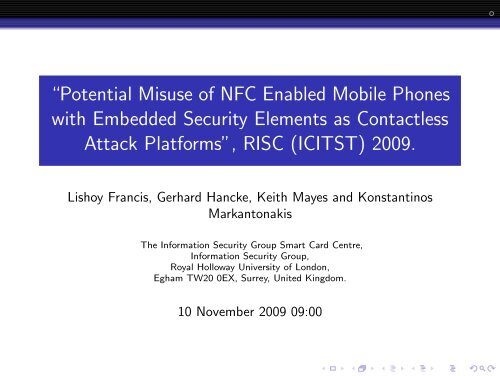``Potential Misuse of NFC Enabled Mobile Phones with Embedded ...
``Potential Misuse of NFC Enabled Mobile Phones with Embedded ...
``Potential Misuse of NFC Enabled Mobile Phones with Embedded ...
You also want an ePaper? Increase the reach of your titles
YUMPU automatically turns print PDFs into web optimized ePapers that Google loves.
“Potential <strong>Misuse</strong> <strong>of</strong> <strong>NFC</strong> <strong>Enabled</strong> <strong>Mobile</strong> <strong>Phones</strong><br />
<strong>with</strong> <strong>Embedded</strong> Security Elements as Contactless<br />
Attack Platforms”, RISC (ICITST) 2009.<br />
Lishoy Francis, Gerhard Hancke, Keith Mayes and Konstantinos<br />
Markantonakis<br />
The Information Security Group Smart Card Centre,<br />
Information Security Group,<br />
Royal Holloway University <strong>of</strong> London,<br />
Egham TW20 0EX, Surrey, United Kingdom.<br />
10 November 2009 09:00
..<br />
◮ Part I: Overview <strong>of</strong> <strong>NFC</strong> <strong>Enabled</strong> <strong>Mobile</strong> <strong>Phones</strong>.<br />
◮ Part II: Proposed Security Attacks.<br />
◮ Part III: Proposed Security Countermeasures.<br />
◮ Part IV: Conclusions.
Part I<br />
Part I<br />
Overview <strong>of</strong> <strong>NFC</strong> <strong>Enabled</strong> <strong>Mobile</strong> <strong>Phones</strong>
Part I<br />
.<br />
Overview <strong>of</strong> <strong>NFC</strong> <strong>Enabled</strong> <strong>Mobile</strong> <strong>Phones</strong><br />
Objective:<br />
To investigate the potential misuse <strong>of</strong> <strong>NFC</strong> (Near Field Communications)<br />
enabled mobile phones <strong>with</strong> embedded Security Element (SE).<br />
◮ <strong>NFC</strong> is a short range and standardised (ISO 18092) wireless<br />
communications technology (adds contactless functionality to mobile<br />
devices, e.g. mobile phones and PDAs).<br />
◮ <strong>NFC</strong> enabled mobile phone can act both as a “contactless card” and<br />
a “contactless reader” (supports ISO 14443, ISO 15693, FeliCa and<br />
Mifare Standard).<br />
◮ <strong>NFC</strong> finds applications in ticketing, banking, access control, etc and<br />
is tipped to be the next ’click’.<br />
◮ Three architectures currently exist, SE as embedded hardware<br />
module; SE functionality integrated into the Subscriber Identity<br />
Application module such as (U)SIM; SE as removable memory<br />
component (Secure MMC, Secure SD).
Part I<br />
.<br />
A functional view <strong>of</strong> the <strong>NFC</strong> enabled <strong>Mobile</strong> Phone<br />
showing relevant APIs and operational modes
Part I<br />
.<br />
Security <strong>of</strong> <strong>NFC</strong><br />
Secure Element (SE):<br />
◮ controls the <strong>NFC</strong> based transactions,<br />
establishes the trust between service<br />
provider and the mobile phone.<br />
◮ designed to provide a secure platform for<br />
containing sensitive applications and key<br />
material.<br />
◮ The SE supports Java Card 2.2.1 (Java<br />
Card Open Platform), Global Platform<br />
2.1.1 & Mifare Standard emulation.<br />
◮ The mobile phone vendor allows SE<br />
“unlocking”, which sets the<br />
authentication keyset to a known public<br />
value.
Part I<br />
.<br />
Security <strong>of</strong> <strong>NFC</strong><br />
Related Contactless Security Attacks:<br />
◮ Contactless token skimmers and emulators currently exist, but a<br />
<strong>NFC</strong> phone platform <strong>of</strong>fers distinct advantages in that it is a small,<br />
mobile device and more importantly that is has an acceptable form<br />
factor, i.e. it does not physically look like a skimmer or an emulator.<br />
◮ Heydt-Benjamin et.al. 2007 (skimming, replay and relaying on<br />
payment systems).<br />
◮ E-passport clones (Steve Boggan article in Times, August, 2008).<br />
◮ Designs for hardware emulators for ISO 14443 tokens (Carluccio<br />
et.al., R. Verdult, 2006); & hardware skimmers, available for<br />
purchase (OpenPCD.org; HF RFID Demo Tag, IAIK, Graz).<br />
◮ We demonstrate how a <strong>NFC</strong> mobile phone can be configured as a<br />
contactless reader which may be used as a contactless skimming<br />
tool, and how the attacker can use the gathered information to<br />
create a “clone” by emulating a token.
Part I<br />
.<br />
<strong>NFC</strong> <strong>Enabled</strong> <strong>Mobile</strong> Phone as a Contactless Card & as a<br />
Contactless Reader<br />
<strong>NFC</strong> <strong>Enabled</strong> <strong>Mobile</strong> Phone as a Contactless Card:<br />
◮ The SE supports Java Card 2.2.1 (Java Card Open Platform),<br />
Global Platform 2.1.1 & Mifare Standard emulation.<br />
◮ The mobile phone vendor allows SE “unlocking”, which sets the<br />
authentication keyset to a known public value.<br />
◮ SE communicates <strong>with</strong> the <strong>NFC</strong> controller, the external reader<br />
device and the applications installed on the mobile phone through<br />
well defined, and standardised, interfaces.<br />
<strong>NFC</strong> <strong>Enabled</strong> <strong>Mobile</strong> Phone as a Contactless Reader:<br />
◮ Nokia 6131 supports S40 platform, providing J2ME layer for MIDP<br />
(<strong>Mobile</strong> Information Device Pr<strong>of</strong>ile) 2.0 applications (MIDlets).<br />
◮ Contactless reader mode uses JSR 257 API to communicate <strong>with</strong><br />
any external SE and if needed uses SATSA (JSR 177) API to<br />
communicate <strong>with</strong> the internal SE.<br />
◮ JSR 257 API Extensions allow <strong>NFC</strong> enabled mobile devices to<br />
communicate in P2P mode.
Part II<br />
Part II<br />
Proposed Security Attacks
Part II<br />
Proposed Security Attacks<br />
<strong>NFC</strong> <strong>Enabled</strong> <strong>Mobile</strong> Phone as an Attack Platform<br />
Practical Pro<strong>of</strong> <strong>of</strong> Concept for the Proposed Attacks:<br />
◮ Transaction Data Capture & Analysis.<br />
◮<br />
◮<br />
Captured RF (Radio Frequency) communication between a<br />
contactless card and a legacy contactless reader in our test system.<br />
The test system is based on a ‘static authentication’ system.<br />
◮ Developing the “Clone”.<br />
◮<br />
◮<br />
◮<br />
By default, the SE on 6131 is locked <strong>with</strong> the Issuer keyset.<br />
Unlockable, the unlocking process sets the authentication keyset to a<br />
known public values (keyset-42).<br />
Java Card Applets which emulated the test application were loaded<br />
and installed on the unlocked SE.<br />
◮ Developing the <strong>Mobile</strong> Pick Pocketing Tool.<br />
◮<br />
◮<br />
A MIDP (<strong>Mobile</strong> Information Device Pr<strong>of</strong>ile) 2.0 application<br />
(MIDlet) running on the mobile phone which reads (skims) the<br />
contactless card.<br />
No code signing was required to use the contactless APIs.
Part II<br />
Proposed Security Attacks<br />
<strong>NFC</strong> <strong>Enabled</strong> <strong>Mobile</strong> Phone as an Attack Platform<br />
a) Custom-built Sniffer & Card<br />
Emulator.<br />
b) Skimming & Cloning using <strong>NFC</strong><br />
<strong>Mobile</strong> Phone.
Part III<br />
Part III<br />
Proposed Security Countermeasures
Part III<br />
Proposed Security Countermeasures<br />
Security Countermeasures<br />
◮ Timing, RF Shielding may not work.<br />
◮ Control measures on the <strong>NFC</strong> Secure Element (SE).<br />
◮ Making code signing mandatory for <strong>NFC</strong> communications API.<br />
◮ Securing the <strong>NFC</strong> Secure Element activity.<br />
◮ Cryptographically linking the application to Unique Identifiers.<br />
◮ Application Protocol <strong>with</strong> strong cryptography (for e.g. dynamic<br />
authentication).
Part IV<br />
Part IV<br />
Conclusions
Part IV<br />
Conclusions<br />
Conclusions<br />
◮ <strong>NFC</strong> enabled <strong>Mobile</strong> <strong>Phones</strong> are found to be easily configured as<br />
Cloning, Skimming Platforms.<br />
◮ Legitimate form-factor <strong>of</strong> mobile phone arouse less suspicion in the<br />
public.<br />
◮ Easily and freely available development tools.<br />
◮ More security controls needed on the Secure Element.<br />
◮ If not secured, the Secure Element (SE) embedded in certain <strong>NFC</strong><br />
mobile phones could become a platform for malicious s<strong>of</strong>tware.<br />
◮ In conclusion, our findings indicate that the embedded SE <strong>with</strong> the<br />
existing security controls and the available contactless APIs could be<br />
exploited to configure the mobile phone as a contactless attack<br />
platform.






